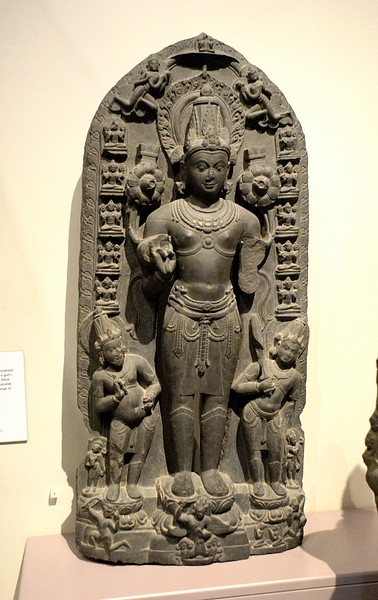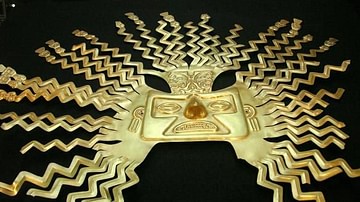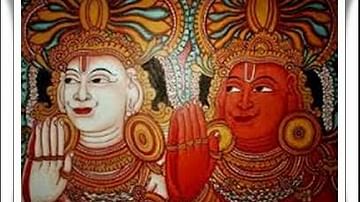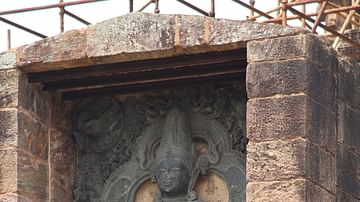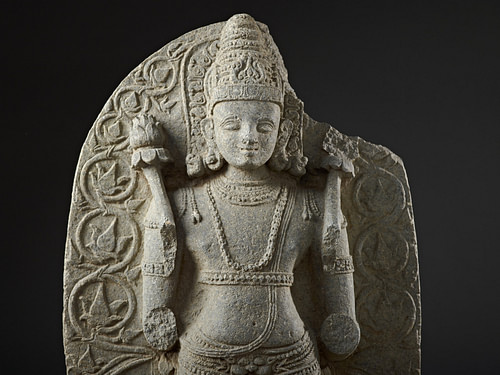
Surya (also known as Aditya) is the Hindu god of the Sun. He is considered the creator of the universe and the source of all life. He is the supreme soul who brings light and warmth to the world. Each day he travels across the sky in his golden chariot pulled by seven horses and driven by red Aruna, a personification of Dawn. The god's most famous temple is at Konarak in Orissa, north-east India but he was worshipped across the Indian subcontinent. Still an important figure in Hinduism today, he is also a minor deity in Buddhism.
Associations & Mythology
Surya is known by many alternative names and epithets which include Vivasvat (Brilliant), Savitr (the Nourisher), Bhaskara (Light-maker), Dinakara (Day-maker), Lokacaksuh (Eye of the World), Graharaja (King of the Constellations), and Sahasra-kirana (Of a 1,000 rays). Vishnu, who later largely replaces Surya's function in the Hindu pantheon, is referred to as Surya-Narayana in his incarnation as the sun.
Surya first appears in literature in the Rigveda, oldest of the Vedas sacred texts and composed between 1500 and 1000 BCE. The bringer of the Sun, Surya was thought to ride his chariot across the sky and defeat the demons of darkness. He is represented as such in a doorway relief at the 2nd-century BCE Buddhist cave temples and monk cells of Bhaja, Shunga in western India.
According to some myths Surya is the son of Kasyapa (a Vedic sage) and Aditi (Infinite Heavens), in others he is the offspring of Dyaus (Sky), and in still others his father is Brahma. Surya had three offspring with Samjna (Conscience), the daughter of Visvakarma. These were Vaivasvata (one of the 14 original men or Manu), Yama (god of the dead), and Yami (goddess of the Yamuna river). Unfortunately, Samjna became so tired of Surya's brilliant light that she one day gave him a handmaid, Chaya (Shade), and left him to live a life of reflection in the forests, transformed into a mare. Surya was not to be so easily deprived though and disguised as a stallion mated with Samjna. The resulting offspring were Revanta (chief of the Guhyakas) and two twin sons, the youthful Ashvins, who travel before his chariot in their own golden version or on horseback.
Meanwhile, Visvakarma chipped off some of Surya's brilliance, perhaps to try and dim the god and make him a little easier for his daughter to live with. From these blazing fragments were made various weapons of the gods, including Vishnu's discus, Shiva's trident, Kubera's club, and Karttikeya's lance.
Various other offspring sometimes attributed to Surya include the monkey chief Sugriva, Ushas, the personification of Dawn in early texts, and Sani, the personification of the planet Saturn. Surya is considered the chief of the nine planets of Vedic antiquity. These are the Sun, Moon, Mercury, Mars, Venus, Jupiter, and Saturn, plus the solar and lunar shadows (ascending and descending nodes) of Rahu and Ketu, all visible to the naked eye. Collectively they are known as the Navagraha.
In other stories involving Surya, the sun-god gave the White Yajurveda (a collection of mantras) to the sage Yajnavalkya. Ever generous, Surya also gave the magical syamantaka gem to Satrajit, a nobleman known for his devout worship of the god. This stone, if the owner were a good person, could produce a huge quantity of gold on a daily basis and dispelled all fears. If the owner was evil, then it proved their undoing with deadly consequences.
Worship
Surya and the Adityas, the collective name for the solar deities, were especially popular in the Vedic period, the sun-god being considered at that time one of the three most important gods. Later, Surya was replaced in importance by such deities as Shiva and Vishnu. Still, to some he remains an important god in both India and Nepal. He is celebrated during the harvest festival of Pongal in southern India and by Tamils in general. Smarta followers also consider him one of their most important gods. Followers of the god are known as Sauryas. Surya appears in the important Gayatri mantra which is recited from the Vedas as a preliminary to its study. Finally, in Buddhism Surya is considered to dwell in and protect shrines.
Temples to Surya
The god had many temples and shrines across ancient India but certainly the most celebrated temple built in honour of Surya is in the Orissa region at Konarak. Constructed in the 13th century CE using sandstone, it has 12 pairs of huge stone wheels incorporated into the sides of the building to represent the months of the year and give the impression the whole temple is the chariot of Surya. The effect is further enhanced by seven horses sculpted at its front and standing either side of the staircase. The cult of Surya was founded at the site by Narasimha I (r. 1238-1264 CE). Statues of the sun-god adorn niches on the temple exterior. One example panel shows Surya wearing a conical crown and standing above his seven chariot horses. He is bedecked in jewels and accompanied by a smaller figure of Aruna.
Another famous temple dedicated to the god is at Martand in the Srinagar valley of Kashmir. It was built in the second half of the 8th century CE by the Karkota king Lalitaditya Muktapida. The limestone temple is an interesting example of the influence of Classical architecture in the region and has fluted columns and Corinthian-like capitals in the rectangular colonnade which measures 67 x 42 metres and surrounds the temple proper. Today the temple is a mere ruin of its former self, but it remains the earliest Hindu monument in Kashmir.
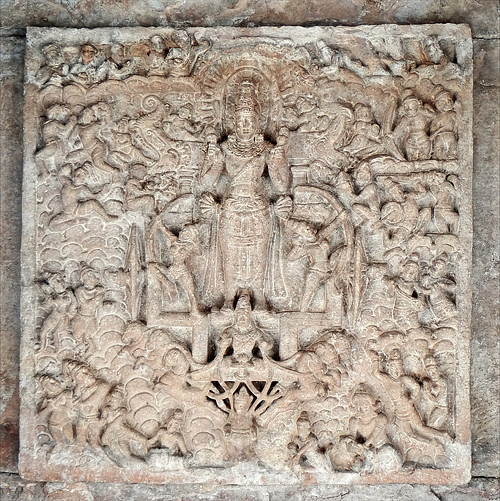
Surya in Hindu Art
Surya appears both in figure sculpture and on temples across India. He is often portrayed wearing tall boots and a flowing tunic which represent his coming from another world (Parthian or Kushan?). This unusual iconography continues right up to the 12th century CE across India; an outstanding example is the bronze figure from Kashmir now in the Cleveland Museum of Art. Surya may ride his chariot led by seven horses or a single horse with seven heads (representing the colours of the rainbow and seven chakras), all with rays of light shining from them. Unlike many other Hindu gods Surya is usually depicted with only two arms and not the typical four. In the Cham art of ancient Vietnam and Cambodia, Surya is often portrayed riding a horse and wielding a huge sword, no doubt, in reference to his daily slaying of the demons of darkness.
Depictions of the god on Ossian temples show Surya holding lotuses in each hand and wearing a jewelled crown and loincloth. The outstanding examples of this type are the green chlorite panel dominated by the life-size figure of Surya from his temple at Konarak, now in the National Museum, New Delhi and the polished slate panel from Ganga Sagar, now in the Philadelphia Museum of Art.
